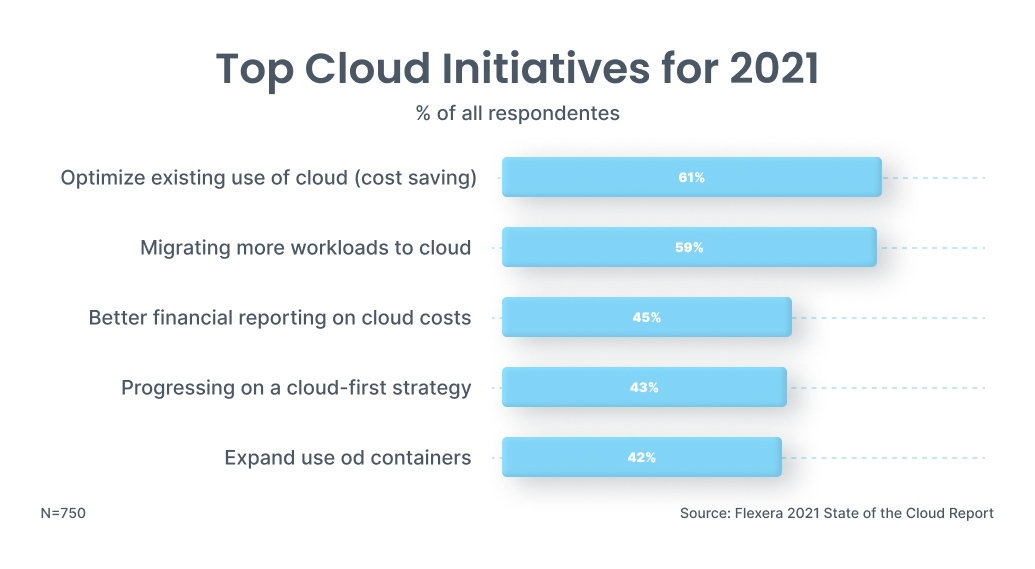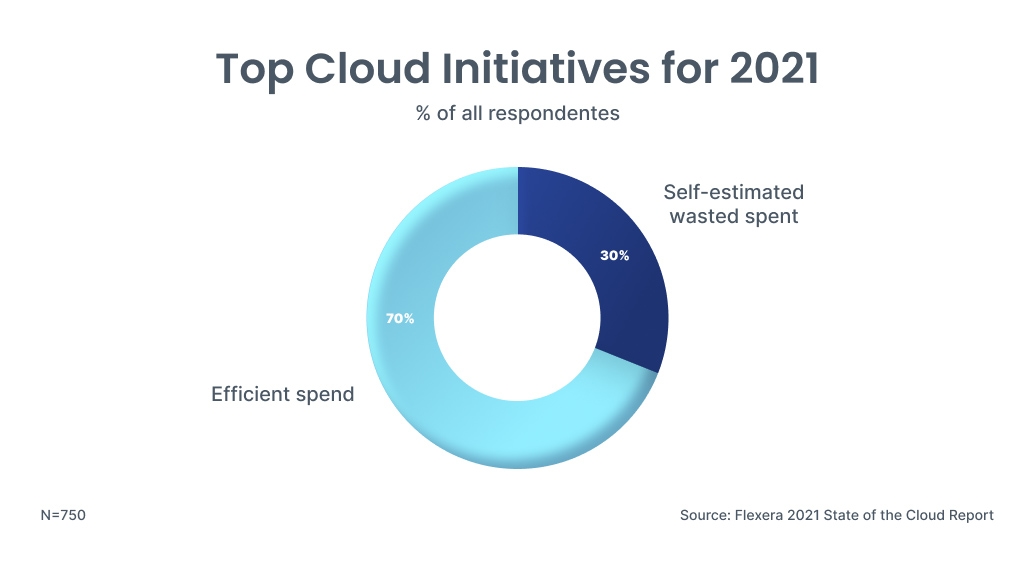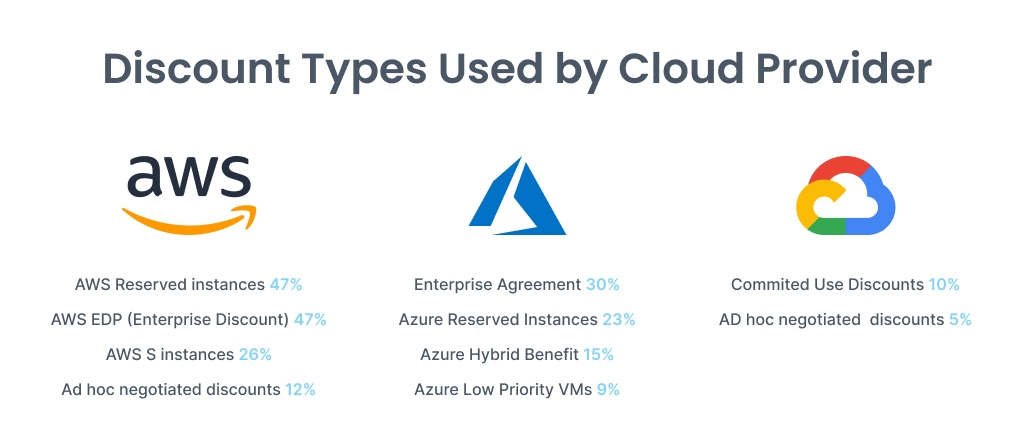
7-Deed Cost-Saving Program To Optimizing The Existing Use Of Cloud
The situation when businesses reduce waste while increasing performance and revenue on the cloud seems to be a shimmering goal for any organization. And despite this topic having been discussed by lots of cloud experts for a couple
of years now, it’s still critical, and, unfortunately, it’s still unsolved. According to
Flexera 2021 State of the Cloud Report, cloud waste optimizing is the top cloud challenge for the fifth
year in a row outpacing migrating more workloads to the cloud and improved financial reporting on cloud costs. What makes this puzzle that insoluble? What can we propose to address this issue effectively? Keep on reading.

Why optimizing spending is top cloud initiative for the fifth year running
Clouds are supposed to help with money waste, aren’t they? Isn’t that why 92% of enterprises have a multi-cloud strategy and 82% have a hybrid cloud strategy, states
Flexera 2021 State of the Cloud Report? Yes, you’re right, however, FinOps practitioners name gigantic $45
billion in cloud spend annually, revealing “…a little secret about the clouds that the bill never goes down” in their recent report. Organizations waste significant cloud
spending that has become a major issue as cloud costs continue to rise. Flexera’s responders self-estimated that their businesses waste more than 35% of cloud spending.

We can give 7-L reason-kit why companies get into this money trap:
- Lack of time. Cloud migration and cloud-based infrastructure building with hard deadlines will likely lead to making mistakes and either grabbing every service possible or skipping important steps. As a result, bills do not go
down and businesses don’t get satisfying outcomes. - Lack of experience. Teams are not experienced enough to complete cloud migration and configure correct cost optimization management.
- Lack of skills. Teams might experience a lack of necessary skills. Especially if we talk about small business and startup teams.
- Lack of people. Small teams might not find people to complete such a time and energy-consuming task after all.
- Lack of visualization. Understanding the infrastructure’s current state is crucial. That’s why it’s quite helpful
to implement a cloud visualization platform for you to get a solid understanding of the cloud insights. - Lack of monitoring. Monitoring deficiency and lack of regularly evaluating the actually received cloud service versus planned expectations is a quick way to waste cash and degrade critical business operations.
- Lack of proper automation. Automated computing resources provisioning is one of the sweetest benefits of cloud infrastructure, however, blindly trusting automation scripts from cloud providers would be a big mistake.
Additionally, cloud providers are often not really clear about cloud pricing. It’s not that they are trying to trick us, but it might be difficult to deal with tangled cloud price mapping for people who are not cloud-gurus. Let’s
take a look at this simple example, your goal is AWS Lambda (cloud execution) and you have a web app using CloudFront CDN. You are developing a flow like this – when the client interacts with the application, it fires an HTTP
request through the API gateway, which calls a Lambda function that takes the data and stores it in DynamoDB. Piece of cake, right? But with this scenario played, you will use 4 cloud services. Surprised? Let’s calculate, you need a
CloudFront CDN to collect data, an API Gateway to route HTTP requests, Lambda itself to handle the request, and finally DynamoDB for storage. Each of them charges well, pretty soon you will face bills with ugly numbers.
7-deed program to optimize existing cloud costs
-
- Make cloud cost handling a part of the SDLC (Software Development Life Cycle). This may seem a bit overwhelming, but the cost should be part of the SD lifecycle. In this case, cost transparency is very important, and you will
need a rigorous tagging methodology for each cloud service that will be tied to each microservice it consumes, for each environment, for each team. Developers and the IT operations team need to control costs to promote sound
engineering and financial behavior. The right size and auto-scaling of the infrastructure can be done in any number of ways and software, from Github-as-a-service features to innovative
cloud management platforms such as ProfiSea Labs. More importantly, it is an ongoing assessment process that includes good monitoring of your application and
infrastructure. - Govern cloud handling. The management of this growing area of expenditure is not yet firmly entrenched in most businesses; most respondents in
Flexer’s report (84% of businesses and 73% of SMEs) cite this as a major cloud computing challenge. Centralized cloud teams that can
set and enforce policies for spending on cloud services exist in 66% of enterprises. The majority of enterprises (68%) see cloud management as the responsibility of central IT teams. Despite this understanding, cloud management
is lagging. - Monitor & Slash cloud waste. Obviously, organizations do not have a complete understanding of how they overspend in the cloud. We already discussed that Flexera estimated that wasted cloud spending is 35% (and even much
higher). So, actionable ways of cloud waste effective reduction, including estimating capacity, auditing,
spinning down and auto-scaling you should definitely consider trying. - Master discounts. Despite cloud providers offering discounts, most companies do not take full advantage of these savings opportunities. AWS, Azure, and Google offer different types of discounts, offering options that can meet
your company’s cost optimization needs. For instance, only 47% of AWS users and 23% of Azure users benefit from Reserved Instances (RIs), which reserve resources and capacity at a lower cost than price on demand. And only 26% of
CSP’s users convert their instances into spots thereby saving up to 90%. Yes, you are right, these discount options management is quite a challenging task for cloud-non-experts, however, you can use a
next-gen cloud management platform to avoid costly miscalculations and get AI-powered saving recommendations.
- Make cloud cost handling a part of the SDLC (Software Development Life Cycle). This may seem a bit overwhelming, but the cost should be part of the SD lifecycle. In this case, cost transparency is very important, and you will

Source: Flexera 2021 State of the Cloud Report
- Automate Policies. As new cloud resources are constantly added/removed, cloud resource spending can be very dynamic. Manual approaches to cutting waste can seem useless like cleaning up toys in the nursery – you tidy up one
corner while the other one is cluttering simultaneously. That’s where simple automation saves the day and helps organizations optimize their cloud investments. Automation is becoming critical in this rapidly changing
environment. While companies should use automated policies to continually optimize costs, only a limited number of companies have started this process. - Use a standalone product that simplifies and automates cost data by increasing transparency. Keeping teams and budgets up and running is a very time-consuming and energy-intensive process. In manual mode, it includes most of
your and your team’s resources spent on planning, labeling, sizing, and of course, management.If you want your team to be involved in the budget management process and you don’t want them to focus only on monetary issues, you
should use the product to increase the visibility of your spending. With this innovative multi-cloud management platform in place, you will be provided with information
on the costs of each service, which will help you optimize your budget and prevent additional costs. - Reaching experienced DevOps
is a very good idea for SMBs and startups due to the lack of skilled experienced professionals sufficient to enable the cloud spending phase in SDLC, create a product that optimizes and visualizes cost data, or at least
implements decent cost optimization automation for your cloud infrastructure.
Bottom line
About 90% of companies spend more than a million dollars a year on cloud services, given their desire to cope with the problem of unnecessary expenses. Lack of time, qualified specialists, lack of experience with the cloud and, of
course, a complex price map from cloud providers make it difficult to choose services. Thus, the addition of a lack of explicit billing visibility often results in a loss of cost control. Quite frankly, the main problem is that
organizations do not take full responsibility for managing cloud budgets. Budget planning and management should be as much a part of the project life cycle as development and implementation. We offer seven practical ways IT
companies can manage budgets and control existing cloud spending. If you have any DevOps/CloudOps related questions, please contact us for a free consultation.